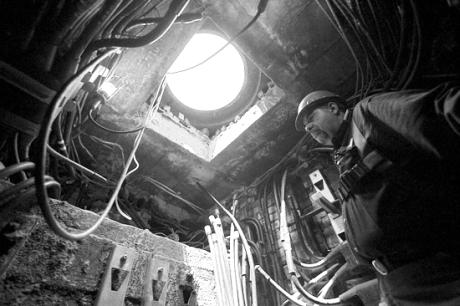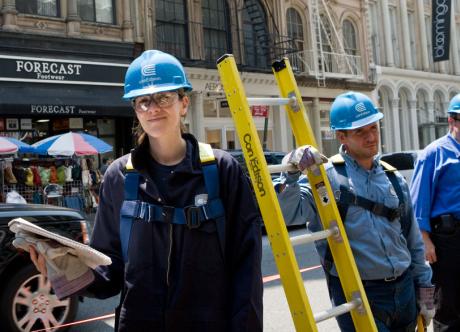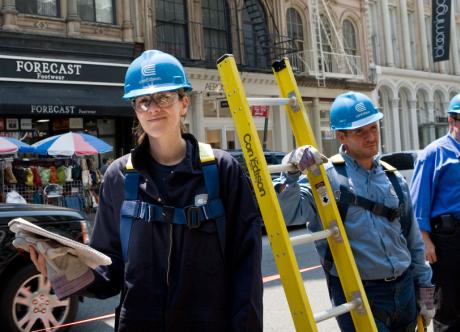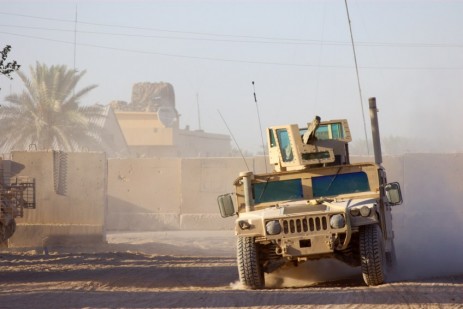 The bowels of New York City’s electricity system.Often referred to as “the world’s biggest machine,” the North American electricity grid as a whole is an integrated network of generators and millions of miles of wires that crisscross the United States and Canada. It snakes across fields, over mountains, through tunnels, along highways, beneath sidewalks, under rivers and seas. If you live anywhere in Canada or the continental United States, this mega-machine “reaches into your home, your bedroom,” as one writer put it, “and climbs right up into the lamp next to your pillow.”
The bowels of New York City’s electricity system.Often referred to as “the world’s biggest machine,” the North American electricity grid as a whole is an integrated network of generators and millions of miles of wires that crisscross the United States and Canada. It snakes across fields, over mountains, through tunnels, along highways, beneath sidewalks, under rivers and seas. If you live anywhere in Canada or the continental United States, this mega-machine “reaches into your home, your bedroom,” as one writer put it, “and climbs right up into the lamp next to your pillow.”
The grid is designed as a hub-and-spoke system, in which large centralized generators supply electricity to thousands of end users. All told, the U.S. grid has about 300,000 miles of high-voltage transmission lines and 5.2 million miles of local distribution lines. When one cable in a network short-circuits, others nearby will automatically pick up the burden. But if the surrounding cables are also overstressed, they too can fail, causing a cascading effect that can knock out major portions of a network.
In recent years, the U.S. power grid has become increasingly prone to such interruptions. Average temperatures have risen, homes have gotten bigger, and so have air-conditioning demands. Thanks to our technology-rich lifestyles and the inefficiency of our buildings and power plants, Americans consume, per capita, at least 50 percent more electricity annually than the citizens of Europe and Japan.
But we don’t have the infrastructure to support our lavish habits. We’ve seen almost no expansion or evolution of the grid that struggles to sustain our skyrocketing demands. Former Energy Secretary Bill Richardson has explained the problem this way: “We’re a major superpower with a third-world electricity grid.” The average age of the equipment that makes up our grid infrastructure is more than forty years, and many components were designed and installed before World War II. If we’re to see a major shift toward greener, more reliable power sources, we need a simultaneous upgrade in grid transmission technology.
*
I got a firsthand look at the challenges our power system is facing when I climbed inside the New York City grid. Con Edison’s chief of underground grid maintenance, Dennis Romano, had agreed to accompany me down below with his crew of electrical engineers to explain what I was seeing. A jovial man with a permanent five o’clock shadow, Romano seemed amused if a bit baffled at my excitement over this brief trip.
 Amanda Little, ready to go down the manhole.In spite of what I’d learned about the grid’s fragility, I had a fanciful notion of what I’d encounter: a vast, orderly chamber 50 feet underground containing thousands of gleaming wires all labeled and mapped according to the neighborhoods and buildings they fed, gauges glowing to indicate the volumes of current coursing on each line — as clean and intricate as the innards of the world’s biggest iMac.
Amanda Little, ready to go down the manhole.In spite of what I’d learned about the grid’s fragility, I had a fanciful notion of what I’d encounter: a vast, orderly chamber 50 feet underground containing thousands of gleaming wires all labeled and mapped according to the neighborhoods and buildings they fed, gauges glowing to indicate the volumes of current coursing on each line — as clean and intricate as the innards of the world’s biggest iMac.
Instead, my descent into a manhole on lower Broadway lasted all of 17 feet-and the shallow tunnel I crouched through opened onto a chamber roughly the size of an average walk-in closet. The floor was covered with a murky pond of street runoff, crumbled asphalt, and garbage fragments, and the air was clammy and foul. The walls revealed a gory cross section of the grid: emerging from dozens of cement ducts was a spaghettilike tangle of grimy wires pulsing with so much electric current I could see them vibrate, like hoses with liquid gushing through them.
The New York City grid encompasses more than 80,000 miles of cable-enough to circle the globe four times. Peel back the sidewalks of Manhattan and you’ll find a larger concentration of copper than anywhere else on the planet-more, in fact, than in the world’s largest copper mine. All that metal can be found within 15 feet below street level, sandwiched in with water mains, sewage pipes, and telephone lines. (These pipes and tubes are constantly in need of repair, so they have to be placed close to street level for speedy access.) There is no large central chamber where all the wires are organized, labeled, and monitored; instead, there are some 260,000 manholes throughout the city, each one providing access to the wires feeding just a handful of buildings.
Many of these cables are over fifty years old. As the wires age, they degrade under a battery of stresses. The combination of sweltering heat in the summer and freezing cold in the winter causes them to expand, contract, and weaken. The constant vibrations of the city and its underworld-rumbling subways, feet pounding on pavement, incessant traffic-can wreak havoc over time. When water mains break and sewage lines overflow, they can soak and erode grid equipment. When salt is scattered on snowy streets, it often eventually drips into street cracks and manholes, eating away at the cables’ insulation. Equally common is a nick in a cable from a construction worker’s jackhammer or backhoe.
Any one of these burdens can overstress and shut down a wire. But the biggest challenge facing New York City is its outsized electricity demand, which is growing at a rate of nearly 2 percent a year. That doesn’t sound like much, but it translates to an additional annual load of 200 megawatts-enough to power nearly a quarter million homes or a midsized city. “It’s like moving Albany onto the New York City grid every year,” Con Edison’s president later told me. That’s a big challenge when you have a system as congested as Con Ed’s.
“See what I mean? The grid is running out of room,” Dennis Romano said as we huddled in the dank manhole, gesturing at a mass of wires so dense it was like a Friday afternoon traffic jam at the mouth of the Holland Tunnel. “There’s just no space down here to put more copper.” The lines, he added, can only carry a finite amount of electricity: “You can’t put ten pounds of baloney in a five-pound bag.” Romano was describing gridlock in the most literal sense-the grid in its current form is reaching a physical threshold, meaning it can’t be built out any further.
“At the rate our demands are growing,” Romano said, “we could outgrow the grid in under ten years.” When we ventured back up to street level, I could see why: New York was voraciously guzzling power. Bank machines were whirring, flat-screen monitors were flickering, and an Old Navy store had flung its doors wide open, sending a misty plume of air-conditioning out into the stifling 90-degree heat. Across the way, Banana Republic and Bloomingdale’s were doing the same. “That right there,” said Romano, nodding toward the open doors, “is why the grid gets hammered in summer months. People assume we can air-condition the streets. They just don’t think about it.”
Lou Rana, Con Ed’s president, did offer some encouraging news about the direction of the energy industry today when we discussed his plans to renovate New York City’s complex, aging grid. For nearly two hours, Rana excitedly discussed the “smart grid,” which he described as a “high-tech, superefficient, ultrareliable, self-healing, … clean, green electricity machine.”
Con Ed has already been experimenting piecemeal with some components of a smart grid, which Rana mapped out for me, drawing squiggly lines on a whiteboard. He’s been testing superconductor wires that carry far bigger loads than do the current copper cables and reduce the energy lost in transmission from 10 percent to less than 2 percent.
Rana’s engineers are installing nanosensors that can monitor electrical current flows remotely, allowing grid operators to track and contain power surges before they begin to cascade. Rana is also developing a plan to obtain 20 percent of New York’s City power supply from small-scale distributed power sources — solar panels and clean-burning microplants fueled by natural gas, for instance — installed on apartment and office buildings. This would help address the problem of building big new power plants and transmission lines on extremely limited real estate.
None of these ideas can be implemented on a large-scale basis without a major investment. A full smart-grid conversion would cost tens of billions of dollars for New York City alone. It remains to be seen who, if anyone, will be willing to pay for such a change. New York consumers famously resist rate hikes, and the state’s coffers are running low. Even with sufficient funds, it’s not clear whether the system could be installed in time before the grid’s demands finally outgrow supply, as ever more of its aging components collapse under pressure. The easier path would be to continue replacing the grid piecemeal., copper wire by copper wire. But this won’t do in the long run. Without the smart grid, more and bigger blackouts could lie ahead as demand grows in a system with limited capacity for expanded supply.
The United States is expected to see a 29 percent growth in electricity demands between now and 2030. But that number doesn’t take into account a vast new market that could open up: electric vehicles. As hybrid cars are growing in popularity and new plug-in models are soon to be introduced, the futurists of today are envisioning a century in which all transportation is powered by electricity. The whole energy system, they believe, will be unified under the flow of electrons.
This seems almost laughable given the current fragility of the U.S. electricity supply system. How, I wondered, can we confidently move toward an all-electric future if we’re operating on a Third World electricity grid? One way or another, by necessity if not by choice, the archaic system of plants and cables has to be rebuilt. Will it be replaced with the same old twentieth-century fossil fuels, mechanical switches, and copper wires? Or will we opt for a smart grid and usher in a generation of clean, sustainable technologies?
“The mind can not conceive,” said Thomas Edison in 1916, “what man will do in the twentieth century with his chained lightning.” And a lot we did, to be sure.
But now it’s time to start conceiving what we’ll do in the 21st century — and there’s no time to waste.
This piece was excerpted from Amanda Little’s book Power Trip: From Oil Wells to Solar Cells—Our Ride to the Renewable Future.



